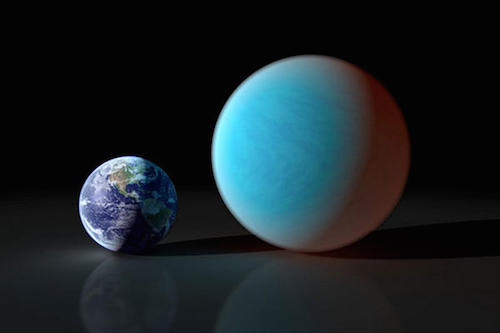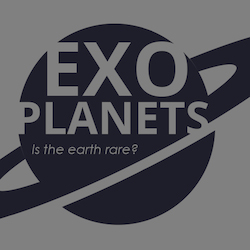 Physics, Earth & Space
Physics, Earth & Space
What About the Actual Data We Have Been Acquiring About Exoplanets?

Editor’s Note: As a series at ENV, we are pleased to present "Exoplanets." Daniel Bakken is an engineer who teaches astronomy at the college level, and an entrepreneur in compound semiconductor crystal growth. In a series of articles he critically examines recent claims about exoplanets beyond our solar system, asking whether our own planet Earth is a rarity, or common, in the cosmos. For previous articles in the series, see here.
 "Earthlike exoplanets" are a favorite subject of science and popular media reporting. A headline from yesterday’s Christian Science Monitor, for example, announces, "Ground-based telescope spots alien ‘Super-Earth.’" Well over a thousand are now known, all detected within the last twenty years.1 It is important to understand how we have been discovering these exoplanets, since it greatly affects the kinds of exoplanets we know about, and the necessity of using statistical methods to get at the actual population of exoplanets.
"Earthlike exoplanets" are a favorite subject of science and popular media reporting. A headline from yesterday’s Christian Science Monitor, for example, announces, "Ground-based telescope spots alien ‘Super-Earth.’" Well over a thousand are now known, all detected within the last twenty years.1 It is important to understand how we have been discovering these exoplanets, since it greatly affects the kinds of exoplanets we know about, and the necessity of using statistical methods to get at the actual population of exoplanets.
Almost all exoplanets are discovered through two different methods. The first is by looking for the gravitational tugs that planets give to their parent stars. By carefully examining the spectral lines of stars, we can measure Doppler frequency shifts in very small amounts. These shifts tell us about how stars are moving ever so slightly towards and away from us, caused by the gravity of the planets that orbit these stars. The star is pulled towards us when the planet swings our way, and away when the planet moves further from us in its orbit. This method has discovered about 565 planets around 424 stars.2
The other method is the transit technique. When planetary orbits around stars bring the planets between us and their host stars, there is a slight but detectable dip in the light from that star.3 Space-based measurements are preferred for this method, and over 3,500 candidates were discovered by the Kepler satellite before it ended its mission prematurely, with 974 of those now confirmed as planets.4 The other satellite mission, CoRoT, has detected about 100 candidates.5 Another method is similar, but it uses the gravitational lensing effect, called microlensing, of a planetary system transiting a background star, and has discovered more than 30 planets.6 Many of the planets discovered are in multi-planet systems. Scientists had discovered 1792 planets in 1112 systems as of May 2014.7
It is important to understand that, contrary to popular media accounts of habitable planets being found, the information we can gather on exoplanets is very limited. James Kasting, one of the leading researchers of exoplanets opined, "None of these announcements of planets in or near the habitable zone should be big news by themselves. They are in a way meaningless, because we presently can’t follow up on the initial act of discovery."8 We can get an approximate planet size from the transit method, because of the percentage of light blocked from its parent star. From the Doppler method, we can estimate mass compared to its parent star. When both can be applied to the same exoplanet, we can then estimate density.9 We cannot actually observe the planets. The images in the media of oceans, green continents, and puffy white clouds are just optimistic guesses. At present we cannot determine any of these parameters. Yet the public appetite for such discoveries, and the attendant funding opportunities, make it irresistible to speculate with a bias towards Earth-like twins.
The earliest exoplanets detected were very unlike our solar system. Detection bias in the Doppler wobble method means it is most sensitive to large planets orbiting their parent star quickly. Surprisingly, there are many of these systems with large Jovian type worlds orbiting their parent star very close in with short orbits. These are the so-called "hot Jupiters."10 It was thought that detection bias was responsible for making it appear that our solar system was not typical, yet as more planets of a wider mass range have been detected, the solar system continues to be atypical.
Although detection bias is real for the discovered planets, even with this taken into account, our orderly solar system is not common, with large planets far out in circular orbits, and terrestrial planets close in also with circular orbits. The current estimate calculated from real exoplanet discoveries suggest that "Earth-like" planets may exist around about 11 percent of "Sun-like" stars. Earth-like, though, is defined as one to two times the size of the Earth, receiving between one quarter and four times the energy the Earth receives from the Sun.11 A planet twice the size of the Earth may not seem too much bigger, but when calculating by mass, that is between one and ten times the mass of the Earth. The energy received by these objects represents an unrealistically generous range for the habitable zones of these stars, as shown above. This estimate, then, is likely far too optimistic, and shows a tendency to exaggerate the numbers of habitable planets by the researchers when reporting their work.
The exoplanet findings show that planetary systems with short period orbits are very circular. The tidal effects between these planets and their stars likely cause this circularity.12 This would include the giant planets with tight orbits. The metallicity of a star has a direct correlation with the incidence of giant planets, and also with giant planets in these tight orbits.13 Giant planets with larger orbits in exoplanet systems generally have much more elliptical orbits than the ones in our solar system, and again, metallicity seems to play a role. This is probably in part because higher metallicity in stars seems to increase the number of giant planets, and with more of these planets in a system, the more interactions these planets will have with one another.14
Eccentric orbits of large planets have a negative effect on any terrestrial planets in those systems.15 The number, masses, and locations of large planets also can affect habitability of an Earth-like planet in these systems. For any Earth-like planet in the habitable zone of its parent star, the other large bodies in that system have the potential to cause climate destroying gravitational perturbations. The migration of the large planets inward towards their star after formation also can affect terrestrial planet formation and composition. This migration causes some materials in the planet-forming disc to scatter, or be concentrated in the inner zone.16 This affects water delivery to the terrestrial inner worlds as well, as in Earth’s case. The area where the Earth formed was nearly devoid of water, so it must have come from further out in the solar system. So where did Earth’s water come from? Although comets are frequently suggested, they can only account for about 10 percent of the Earth’s water. The latest models of solar system formation show that Jupiter’s migrations seem to have been the driver to bring water- bearing asteroids to the Earth.17
In all of this it is becoming clear that the Earth’s solar system is far from typical, and that with relatively small changes in the birth of the solar system, the Earth as we know it would not have been possible. The known exoplanet systems, then, can help us gauge whether there even are the possibility of Class I worlds, when all we can detect are the large planets in those systems by looking at their orbits, and eccentricities.
Next up: How solar systems are formed.
References:
(1) Sasselov, The Life of Super-Earths, 3-7.
(2) The Exoplanet Team, "The Extrasolar Planets Encyclopedia," last updated June 2, 2014, accessed June 2, 2014.
(3) NASA Ames Research Center, "How Kepler Finds Planets," accessed May 30, 2014.
(4) NASA Ames Research Center, "Kepler: A Search for Habitable Planets," June 2, 2014, accessed May 23, 2014.
(5) Jacob Aron, "RIP Space Telescopes," New Scientist 218 No. 2924 (July 6, 2013): 1.
(6) Ibid.
(7) The Exoplanet Team, "The Extrasolar Planets Encyclopedia," last updated June 2, 2014, accessed March 10, 2014.
(8) Lee Billings, Five Billion Years of Solitude: The Search for Life Among the Stars (New York: Current, 2013), 164-165.
(9) Gonzalez, "Setting the Stage for Habitable Planets," 45.
(10) Gonzalez, "Setting the Stage for Habitable Planets," 45.
(11) Eric Petigura et al., "Prevalence of earth-size planets orbiting sun-like stars," PNAS 110 No. 48 (November 26, 2013), 19278.
(12) Gonzalez, "Setting the Stage for Habitable Planets," 48.
(13) Ibid.
(14) Gonzalez, "Setting the Stage for Habitable Planets, 49.
(15) Ibid., 50.
(16) Ibid., 41.
(17) Ibid.
Image credit: NASA/JPL.
